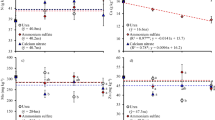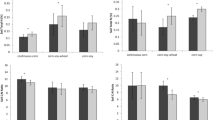Abstract
Crop yields are often increased through crop rotation. This study examined selected soil chemical and physical properties that may constitute the N and non-N related effects of crop rotation in potato cropping systems. Potato (Solanum tuberosum L. Norwis) was grown continuously and in two-year rotations with annual alfalfa (Medicago sativa L. Nitro), hairy vetch (Vicia villosa Roth), white lupin (Lupinus albus L. Ultra), and oat (Avena sativa Astro). Hairy vetch contributed more residue N than any other crop rotation, ranging from 110 to 119 kg N ha−1. Inorganic N concentrations in potato soils were related to the previous crop’s residue N contents, and were highest following vetch and alfalfa and lowest following oat and potato. The highest mineralizable N concentration was found following vetch (46.6 mg N kg−1). Saturated soil hydraulic conductivity in potato following all rotations ranged from 9.88 to 11.28 cm h−1 compared to 5.71 cm h−1 for continuous potato. Higher soil water contents were maintained in the 30 to 45 cm depth for all rotations compared to continuous potato. Thus several parameters indicate substantial N effects associated with particular crop rotations. Soil hydraulic conductivity and soil water status may also represent significant components of the rotation effect not directly related to N for these cropping systems.
Similar content being viewed by others
Literature Cited
Altieri, M.A. 1987. Agroecology: the scientific basis of alternative agriculture. Westview Press Inc. Boulder, CO.
Blake, G.R. and K.H. Hartge. 1986. Bulk density.In: A. Klute (ed.). Methods of soil analysis. Part 1. 2nd ed. Agronomy 9:363–375.
Bullock, D.G. 1992. Crop rotation. Critical Rev Plant Sci 11:309–326.
Gianello, C. and J.M. Bremner. 1986. A simple chemical method of assessing potentially available organic nitrogen in soil. Comm Soil Sci Plant Anal 17:195–214.
Hargrove, W.L. 1986. Winter legumes as a nitrogen source for no-till grain sorghum. Agron J 78:70–74.
Heichel, G.H. 1987. Legumes as a source of nitrogen in conservation tillage systems, p. 29–35. In:J.F. Power (ed.). The role of legumes in conservation tillage systems. Soil Cons Soc Am.
Hesterman, O.B., M.P. Russelle, C.C. Sheaffer, and G.H. Heichel. 1987. Nitrogen utilization from fertilizer and legume residues in legume-corn rotations. Agron J 79:726–731.
Honeycutt, C.W., W.M. Clapham, and S.S. Leach. 1995. Crop rotation and N fertilization effects on growth, yield, and disease incidence in potato. In press.
Keeney, D.R. and D.W. Nelson. 1982. Nitrogen-inorganic forms.In: A.L. Pageet al. (ed.). Methods of soil analysis. Part 2. 2nd ed. Agronomy 9:643–698.
Klute, A. and C. Dirksen. 1986. Hydraulic conductivity and diffusivity: laboratory methods.In: A. Klute (ed.). Methods of soil analysis. Part 1. 2nd ed. Agronomy 9:687–734.
MacRae, R.J. and G.R. Mehuys. 1985. The effect of green manuring on the physical properties of temperate-area soils. Adv Soil Sci 3:71–94.
MacRae, R.J. and G.R. Mehuys. 1987. Effects of green manuring in rotation with corn on the physical properties of two Quebec soils. Bio Agric Hort 4:257–270.
Neeteson, J.J. 1989. Effect of legumes on soil mineral nitrogen and response of potatoes to nitrogen fertilizer, p. 89–93.In: J. Voset al. (ed.). Effects of crop rotation on potato production in the temperate zones. Kluwer Academic Publishers, Boston, MA.
O’Sullivan, J.O. and A.A. Reyes. 1980. Effects of soil fumigation, rotation, and nitrogen on yield, petiole NO3-N, and verticillium wilt of potatoes. J Am Soc Hort Sci 105:809–812.
Russelle, M.P., O.B. Hesterman, C.C. Sheaffer, and G.H. Heichel. 1987. Estimating nitrogen and rotation effects in legume-corn rotations, p. 41–42.In: J.F. Power (ed.). The role of legumes in conservation tillage systems. Soil Cons Soc Am.
SAS Institute. 1990. SAS/STAT Users Guide. Version 6. SAS Institute, Cary, NC.
Scholte, K. 1987. The effect of crop rotation and granular nematicides on the incidence ofRhizoctonia solani in potato. Pot Res 30:187–199.
Specht, L.P. and S.S. Leach. 1987. Effects of crop rotation onRhizoctonia disease of white potato. Plant Dis 71:433–437.
Stevenson, F.J. 1982. Organic forms of soil nitrogen, p. 67–122.In: F.J. Stevenson (ed.). Nitrogen in agricultural soils. Agronomy 22.
Stevenson, F.J. 1986. Cycles of soil carbon, nitrogen, phosphorus, sulfur, micronutrients. John Wiley and Sons. New York, NY
Author information
Authors and Affiliations
Rights and permissions
About this article
Cite this article
Honeycutt, C.W., Clapham, W.M. & Leach, S.S. Influence of crop rotation on selected chemical and physical soil properties in potato cropping systems. American Potato Journal 72, 721–735 (1995). https://doi.org/10.1007/BF02849157
Accepted:
Issue Date:
DOI: https://doi.org/10.1007/BF02849157




